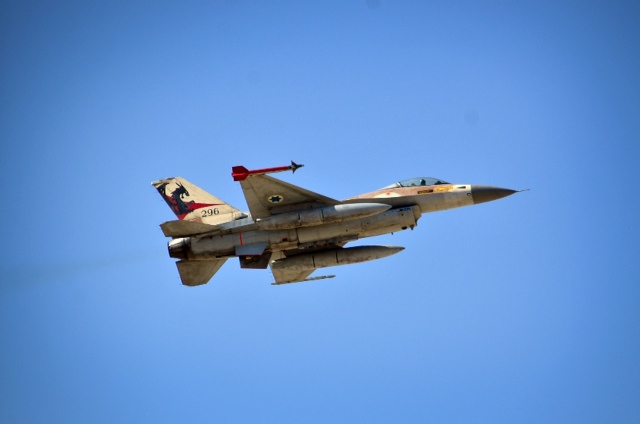Publications
Special Publication, March 6, 2023
The Campaign between the Wars (CBW) has been the IDF’s most important campaign in recent years in Syria. Considerable allocations seek to ensure its continuation and its success – both monetary resources as well as time and attention from Israel’s security and political systems. Israel must continually examine and analyze the effects and implications of the CBW, while promoting actions that strengthen achievements in the sense of realizing the country’s security interests. However, despite the dynamic and evolving situation, Israel clings to a strategy that is not sufficiently effective vis-à-vis new trends and the long-term holistic Iranian strategy. The continuation of attacks at the same rate as in 2022, half of which targeted the Syrian regime, will indeed maintain the restrictions that Assad imposes on the Iranians in Syrian territory, but the cost could exceed the benefit. In its current format, the CBW is challenged by the Iranian response at US forces in the region; the inability to disrupt, and not just delay, Iranian buildup efforts on Syrian soil; and closer relations between Russia and Iran and a tightened “resistance axis.” This is compounded by the lack of a response to the deeper Iranian civilian entrenchment in Syria, which itself demands examination and formulation of a suitable strategy. Taken together, this means that there must be renewed thinking about the objectives and limitations of the CBW, and ways to improve it as part of a broader, updated Israeli strategy for the Syrian arena.
The Campaign between the Wars (Mabam, in its Hebrew acronym; hereafter CBW) has been conducted by the IDF and other security bodies for about a decade, as a campaign serving Israel’s security interests in routine times. It entails a series of actions, whether kinetic or cyber or cognitive, enabling containment of the other side while not crossing the “threshold of war,” and thereby helps to postpone the next war.
In recent years the CBW in Syria has taken the form of a broad kinetic campaign, whose main purpose is to restrict Iranian entrenchment on Syrian soil, and is supplemented by other actions. 2023 began with an attack on Damascus International Airport, which shut down the airport. In late January 2023 there were reports of a series of attacks against convoys of trucks along the Syrian-Iraqi border, apparently aimed at thwarting weapon transports, although the Iranians reported that the convoys were taking humanitarian equipment and fuel to Syria. A more recent attack caused significant damage and deaths of civilians in a civilian neighborhood, against the background of earthquake damage in Syria – and was apparently caused by a Syrian anti-aircraft missile against the aerial attack. The growing frequency of these attacks, attributed to Israel, the civilian friction they create, and the resources they command from the Israeli security establishment demand renewed thinking about the purposes of the campaign, its limitations, and its objectives.
This article looks at the CBW in the years 2018-2022, with an analysis of trends and changes during 2022; assesses its achievements; and offers recommendations for future action.[1]
CBW over the Years
Analysis of aerial attacks in Syria in recent years shows a steady, significant increase in volume. The years 2018-2019 were characterized by a relatively low number of attacks, about 18-22 per year, compared to 32-36 attacks in each of the last three years. The increase reflects how CBW has become a central component of Israeli strategy for dealing with the northern sector. Thus, in the last three years there were an average of three aerial attacks per month, double the average of 1.5 attacks per month in 2018-19. Overall, from 2018-2022 there were 145 aerial attacks attributed to Israel; note that 2022 saw fewer attacks than in the previous year.
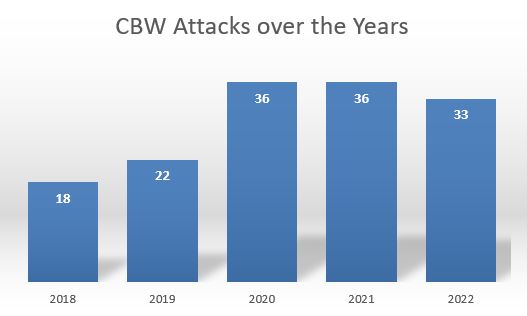
Objectives and Main Trends
In December 2022, then-Chief of Staff Aviv Kochavi confirmed Israel's involvement in the aerial attack on a convoy of trucks on the Syrian-Iraqi border and declared, “Thanks to the many years of [Israeli] military activity in the northern arena, the Iranian vision, which intended to include hundreds of ground to air rockets, tens of thousands of militia troops, and a new Hezbollah in the southern Golan Heights, has been disrupted entirely.”
Although the central CBW objective is to disrupt the military entrenchment of Iran and Hezbollah, about half the aerial attacks in the past year were intended to damage targets linked to the Syrian regime. This reflects the Israeli attempt to drive a wedge between the Syrian regime and Iran and its proxies, ultimately restricting the Iranian presence in Syria. Of the regime targets attacked, 52 percent belonged to the Syrian army, mostly weapons repositories or sites where Iranian troops were housed. A smaller number of attacks were aimed at the Syrian air defenses, apparently in order to maintain Israel’s freedom in the air space. The attacks on Syrian army sites, while damaging to the army and its infrastructure, were intended primarily to send a message to the Assad regime about the cost of cooperating with Iran.
There were six attacks (29 percent) on Syrian national infrastructures, airfields, and ports, including four attacks on airfields. Unlike attacks in previous years on national infrastructures in Syrian territory, aimed at storage sites or specific points and intended to stop weapons transfers without causing significant damage to the function of national infrastructures, the four attacks in 2022 forced the shutdown of the international airports in Damascus and Aleppo, with the physical attack imbued with a clear cognitive objective. In this vein, to exert pressure on the Assad regime. 19 percent of the air attacks in 2022 hit targets linked to the Syrian Ministry of Defense, which is responsible for weapons manufacture for the military. These arms production facilities are also used to make weapons for Hezbollah and the Iranian militias in Syria, so attacking these sites frustrates Syria’s efforts to produce its own military equipment and arm its partners on the radical axis.
Of the aerial attacks on Syria, 54 percent were aimed directly at Iranian targets in the country or Hezbollah or designed to stop transfers of weapons. Herein is a clear CBW focus on physically attacking the presence of Shiite militias with Iranian and Hezbollah support, as well as destroying huge quantities of weapons. Thirty percent of the attacks hit targets linked to pro-Iranian militias in Syria, mostly weapons storage facilities, arms production factories, and military sites. In comparison, only 15 percent of targets were identified with Hezbollah – a figure that matches assessments of the steep reduction of Hezbollah forces in Syria, as implied by Chief of Staff Kochavi. In addition, analysis shows that some Hezbollah targets are strategic objectives, including weapons stores, and some are tactical, such as Hezbollah positions in southern Syria.
Only 9 percent (four attacks) of the air strikes reported in the media in 2022 were designed to thwart weapons transfer. This can be attributed to logistical and operational difficulties and the highly precise intelligence needed to locate such transfers, rather than to any drop in the number of transfers taking place.
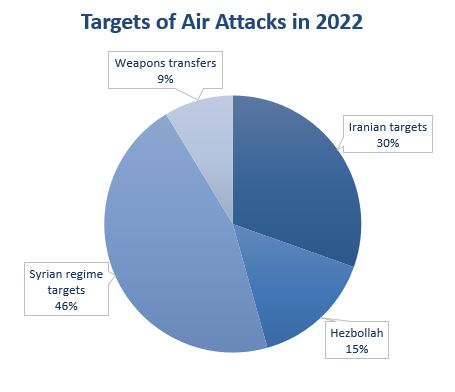
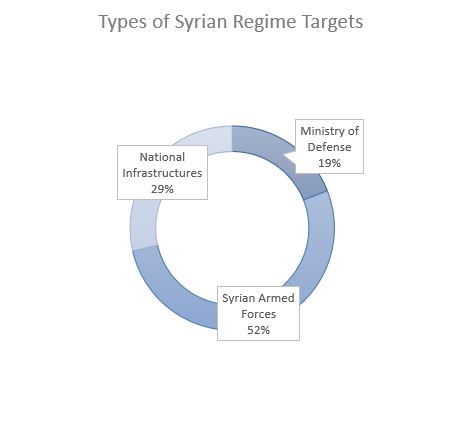
A comparison of the aerial attacks in 2022 with the attacks in 2021 shows that the ratio between the different types of objectives has continued, along with an increase in attacks on Syrian regime targets and a reduction in the number of attacks on weapons transfers. The change can be attributed to the emphasis placed by the Israeli security establishment during the past year on putting pressure on the Assad regime.
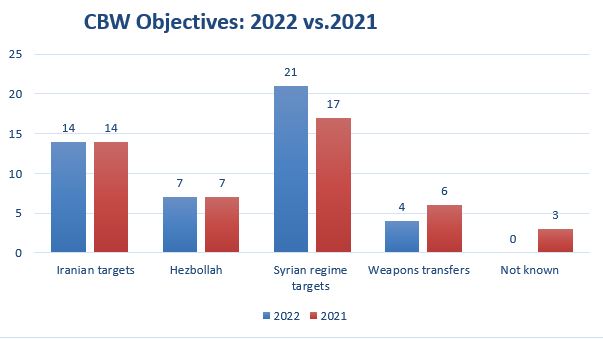
In addition to the attacks on the airports in Damascus and Aleppo, other patterns were identified in CBW actions in 2022 that could be evidence of an increase in Israeli daring in the campaign. In an unusual action, two attacks were carried out in daylight; most attacks were carried out around Damascus and Aleppo close to areas of Russian influence, with the emphasis on Tartus in the west of the country; more than 20 soldiers and officers of the Syrian army were killed, as well as about ten pro-Iranian militia fighters and about ten Syrian civilians. This was in addition to the unusual killing of two Iranian Revolutionary Guards officers, which led to an Iranian strike on US bases.
Achievements and Gaps
In 2022 it was reported that Syria asked Iran and its proxies not to carry out attacks on Israel from its territory, in order to reduce the number of aerial attacks that disrupt the regime’s reconstruction efforts. Indeed, there was no Iranian response (since 2018 there have been no attacks from Syria aimed at Israel). On the one hand, it appears that Assad is restricting Iranian activity in a way that prevents Tehran from implementing its plan to make Syria the scene of friction with Israel and another front in the struggle. In recent years the CBW has managed to severely curtail the extent of Shiite militias in Syria, estimated at around 20,000 fighters, and to thwart a plan to establish a branch of Hezbollah on the Golan Heights.
On the other hand, Israeli deterrence against Iran has led to the formation of a new Iranian response equation, which intensified in 2022. While the Iranians have refrained from attacking Israel, they are not deterred from attacking US forces in Syria in response to Israeli actions. In 2022 there were five attacks on US bases and troops of the international coalition attributed to Iranian militias in Syria, apparently in retaliation for Israel’s aerial strikes – including the al-Tanf base in southern Syria, the al-Shedadi base, the US Consulate in Irbil, and the US base at the Amar oilfield in Deir ez-Zur. These rules of the game continued, when in early 2023 there were four attacks with UAVs and rockets, attributed to Shiite militias supported by Iran, on the al-Tanf base and the US base in Deir ez-Zur. As of now, there have been no casualties, but the attacks illustrate the price the United States is paying for its involvement in the region. This could potentially lead to cutbacks in this involvement, if not withdrawal from Syria – which is contrary to Israeli interests. The United States supports Israel’s fight against Iran's military presence and activity in Syria and gives full backing to the CBW, but further attacks could raise a question mark over continued US backing for the Israeli campaign.
One of the leading achievements of the Israeli campaign is the destruction of most Iranian weapons in Syria. According to the data, only a small number of attacks (9 percent) were intended to thwart transfers of weapons, but the attacks reveal the routes of transfers and often prevent further use of these routes, thus forcing Iran to look for alternatives. An additional 8 percent of attacks in 2022 were intended to damage arms factories on Syrian soil – factories that serve Iran and Hezbollah as well as the Syrian army. Thus the campaign disrupts Hezbollah acquisition of weapons originating in Iran, and also works to disrupt the manufacture of future weapons in the northern arena. However, these actions are not sufficient to prevent all weapons transfers or manufacture. The transfers reportedly continue, and Israel lacks the operational ability to stop them. Often weapons are moved without the approval or knowledge of President Assad, so that pressure on the regime is not an effective way of preventing Iran’s buildup efforts, and they also increase tension between the parties. In addition, over the years the nature of the aerial campaign has encouraged Syria and Iran to look for ways of defending themselves against the attacks, while they continue to build their own strength. Their self-defense includes the establishment of underground weapons production facilities, to create long term resistance to aerial attacks.
In 2022 attacks against Syrian regime targets, particularly those on the international airports, aggravated the tension between Israel and Russia. The war in Ukraine intensified the position of Syria as the scene of a struggle between two multinational blocs – Russia and the eastern camp against the West, led by the United States. In the first months of the war Israel expressed concerns over the restriction of its aerial freedom over Syria and damage to Israeli interests in the area. Although its freedom of action is currently maintained and it appears that the operational coordination between Israel and Russia is still in place, a number of developments over the past year could be evidence of the potential for change, above all, the apparent launch of rockets from Russian S300 air defenses against Israeli planes, strong Russian condemnation in the UN General Assembly of attacks on airports in Syria, and closer relations between Iran and Russia, as shown by the sale of Iranian weapons to Moscow. Iranian military aid to Russia could demand a quid pro quo from Moscow in the Syrian arena, and the Russians could be asked to limit Israel’s aerial freedom, or unfortunately to allow Iran to strengthen its grip and influence on the country.
In addition, recent years have seen a number of strategic processes that increase Iran’s influence in Syria in a way that is not addressed by the CBW. Iran is working to reinforce its civilian entrenchment, infiltrating many aspects of Syrian life – the economy, education, culture and tourism. In 2022 Iran worked tirelessly to extend economic cooperation, including increasing trade between the countries, launching joint economic projects, and removing regulatory restrictions. According to Tehran regime, Iranian exports to Syria doubled last year, and Iran is exploiting the economic crisis in Syria to increase Syrian dependence. It has reinforced cooperation in the field of energy and electricity, implemented joint construction projects, and promoted the involvement of Iranian companies in the rebuilding of Syria. Moreover 2022 saw the revival of the “resistance axis” to Israel, which includes Iran, Hezbollah, Syria, Islamic Jihad, and Hamas. Renewed relations between the Assad regime and Hamas strengthen Syria’s status as an important element in the radical axis. Iran regards all these activities as strategic processes designed to exploit the civilian and political situation in Syria, while hardly being affected by the air attacks of the CBW, which are focused on preventing Iran’s military empowerment in Syria.
Conclusions and Policy Recommendations
The CBW has been the IDF’s most important campaign in Syria in recent years. Huge resources are allocated to ensure its continuing success, both monetary resources and the time and attention of the security and political establishments in Israel. Israel must regularly examine and analyze the impact of the CBW, while promoting actions to reinforce its achievements in the pursuit of Israel’s security interests.
Despite a dynamic and evolving situation, Israel clings to a strategy that is insufficiently effective for dealing with the new trends and Iran’s long term holistic strategy. A continuation of the 2022 pattern of attacks, where half were targeted at the Syrian regime, might ensure that Assad retains the restrictions he has placed on Iran, but the cost might outweigh the benefit. The CBW in its current format is challenged by the equation of the Iranian response against US forces in the region; the inability to disrupt rather than simply delay Iranian efforts to increase its power on Syrian soil; closer relations between Iran and Russia; and the growing strength of the “resistance axis.” This is compounded by the lack of a response to Iran’s deeper civilian entrenchment in Syria. Consequently, the trend must be analyzed and a suitable strategy formed. There is a need for new thinking about the objectives and limitations of the CBW, how to improve it, and how to formulate a broader, updated Israeli approach to the Syrian arena.
Therefore:
- Israel should review its targets in Syria, with the focus on Iranian military entrenchment and arms transfers, while limiting cognitive attacks that do not thwart operations, such as attacks on “civilian” regime objectives.
- While reducing the number of aerial attacks, Israel should reinforce its mechanisms of covert operational activity in Syria, including the allocation of resources to the covert campaign, which has considerable potential for achieving Israel’s security interests in Syria. Inter alia, it is possible to improve cyber activity and the economic war.
- In addition to the CBW, Israel should extend the range of tools at its disposal against the Iranian presence and influence to include diplomatic, economic, and cognitive efforts, possibly in collaboration with relevant countries, above all the United States, Jordan, Turkey, and the Gulf states, as well as sectors in Syria, such as the Druze and the Kurds. This activity would support the military effort aimed at disrupting Iranian activity and would strengthen Israel’s status as an influential and proactive player. There is also a need to work on civilian influences in Syria, as a counterweight to Iranian activity – collaborations with local communities and Israeli involvement in the provision of humanitarian aid in southern and northern Syria. At the same time, Israel must raise awareness among countries of the region and in the global arena of Iranian subversion and its civilian entrenchment in Syria, with the long-term implications of this activity.
- Based on an understanding that the US presence in the area is an essential interest for Israel, there is a need to consider various ways of helping the US defend their forces from attacks by Shi’ite militias, and to examine Israeli responses to attacks on US bases, in order to increase deterrence.
- It is essential to draw up a plan to address potential changes in Russian interests in the area, with the emphasis on shared Israeli and Russian interests, and with close coordination with the United States.
______________________
Thanks to Dr. Carmit Valensi, head of the Northern Front research program at INSS, for her guidance and assistance in writing this article.
[1] The analysis is based on publicly available information only, and therefore might inadvertently include some inaccuracies in the data presented.



